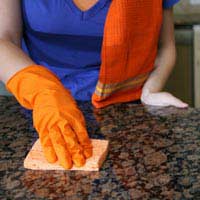
How many times have you finished cleaning your kitchen after a lot of diligence and hard effort, only to look in despair at your still-stained countertops? The taps may be gleaming, the floor spotless and the shelves dust-free but if the countertops are showing nasty, ugly stains, then all your cleaning efforts may seem to be in vain.
Kitchen Countertops and Stains
Unfortunately, kitchen countertops can be very prone to stains as it is under attack’ from a range of liquids, juices, sauces, gravies, oils and more every day. In addition, most are constructed from porous materials which make it especially hard to remove a stain once it has been absorbed and set into the surface. It is best to act immediately after the stain occurs, using paper towels to mop up as much of the staining liquid as possible – otherwise you will have a hard time trying to remove the ingrained marks. As an alternative to paper towels, you can also use corn starch to soak up the stain.
If you did not manage to tackle a stain at the time of its occurrence – after all, most of us only realise and find stains much later – don’t worry. It is still possible in many cases to remove the stain, although you may have to add a hefty bit of “elbow grease” into the recipe!
A Stain Poultice
When faced with a stubborn stain, most people think of grabbing the first abrasive that comes to hand, combined with some soap, and scrubbing the area as hard as possible. Not only will this often have no impact on the strain but it is likely to damage the surface of your countertop, making it even more unsightly and possibly even more prone to stains in the future. The safest way to tackle a stain is to prepare a stain “poultice” which is soaked in an appropriate chemical which is effective against that particular type of stain. The poultice does not have to be anything fancy – just a wad of paper towels soaked in the relevant chemical will suffice.
Determining the type of stain you have is the most important first step as this will then influence the way you tackle it.
Beverage Stains
A lot of kitchen countertop stains are due to people setting cups or glasses of beverages down carelessly, causing a spill which collects and forms a ring around the base of the cup. If not cleaned up immediately, this then sets into the countertop surface and forms a stain ring. This is especially true of tea and coffee, which can leave the most frustrating stains behind. One good way of tacking this – with minimal damage to your countertop surface – is to make up a paste of baking soda and water and gently rub this across the stain, before rinsing and wiping clean. Alternatively, if you know your counter is colour-safe, you could try a mild bleaching chemical soaked into your poultice – for example, hydrogen peroxide – and then use it to wipe over the stained area. Always test the poultice in an unobtrusive corner first, though, to make sure that it does not cause further discolouration.
Rust Stains
The bane of many a proud kitchen-owner’s life, rust stains are formed when metallic pans or utensils are left in countertops for too long, particularly if they are wet or covered in sauces and oils. The best way to deal with them is to actually use a commercially-bought rust remover which can be found in hardware stores. However, be aware that these rust removers usually contain acidic chemicals which can also damage the surface of your countertop so use them sparingly and do not leave them on your countertops for any length of time – always rinse and wipe thoroughly clean.
Oil Stains
Another common stain found on kitchen countertops is oil stains, as a result of cooking and foods like butter, cream and salad dressings. Contrary to what people think (and tend to do), rinsing the area with water will have no effect – and may cause the stain to set in further. The best thing is to soak up as much of the oil as possible using paper towels and then to use some detergent and hard brush to gently scrub the area. Alternatively, you can use a clean cloth soaked in ammonia to wipe the area, followed by your poultice soaked in acetone to wipe the stain clean.
Fruit Juice & Soft Drink Stains
Fruit juices provide a different form of challenge in that they are acidic. Soft drinks also fall into this category. Such liquids can seriously damage the surface of your countertop if left standing on them for too long. Always clean away such spills immediately and rinse the area thoroughly with water. If a stain has formed and set into the countertop, you may find that you will need to “re-polish” the surface of your countertop to get rid of the stain.
To prevent a lifetime of constantly tackling stains on your kitchen countertops, it is best to choose a countertop which has a sealed and polished surface which will be stain resistant. Many modern countertops made with synthetic materials will have stain-proof properties combined with durability – however, be aware that abrasives and scratches, as well as hot pans, can damage the protective coating and make your countertop vulnerable to marks and stains.